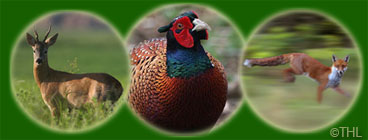
Longnetting
Stage 1 - getting started
Obviously to start longnetting, you need a longnet or two. There are two types of longnet on the market, firstly there is the ‘traditional’ longnet and there is the ‘quickset’ longnet.
Traditional longnets are a length of netting onto two lines, the head line and the foot line. If your lines were 75 yards long, you would want to put at least 150 yards of net onto it, thus giving enough ‘bagging’ ‘slack’ or ‘kill’. At each end of your lines would be an end pin, usually stainless steel or aliminium, this would be a length of metal, pointed at one end and the other end in the form of a loop, smooth welded together so your net dosen’t snag. People use different size loops to suit themselves, some use a 5” loop to stop the net slipping over it, others just over a 2 or 3” loop and bind there net with elastic bands, so the net cant go no-where. These would be tied to the head and foot lines. When picking up your net, these are used, as you hold it by the loop and feed the net onto the shaft.
It is optional that you ‘tie’ the slack at intervals so it dosent blow to one end of the net in the wind, most experienced long-netters wont do this, but you will find that they are a dab hand at sorting out the bagging as they set the net.
You would then need pegs at every 5-9 yards depending on the terrain you are working, these keep the nets upright. Traditionally these were made of hazel, but we are now able to get fiberglass pegs (poles) which are virtually indestructible.
Quickset nets are made the same way as traditional by placing twice more netting onto the lines. Poles are then permanently fixed to the net between 5-8 yards and there is no need for end pins. These are put into a basket.
Stage 2 - revision
If you go into the field within the first hour of daylight, you will see where the rabbits are sitting, and which way they are running. You can also do this at night time with the use of a lamp. You need to work out the easiest way into the field without disturbing the rabbits if needs be, you can place any old logs or fence posts near fences so you don’t ‘twang’ the barbed wire at night. You could take a compass into the field to find out which wind direction is most ideal this will be explained later.
Stage 3 - the right night
You want a nice dark, windy night for longnetting, much like you do for lamping with dogs. The wind should ideally be blowing from the rabbits, to where they want to run. So if they were running south, you want the wind blowing south, east or west is acceptable, but not north. (heres where the compass comes in)

On a set like this the ideal wind would be blowing south, towards your net. If you had an east wind, you would enter the field from the west & vice versa.
Stage 4 - setting the nets
If you have a traditional net, you will insert the first end pin into the ground, you will then walk along with the second end pin in your hand, the net will drop off as you walk. You will then put the other end pin in the ground when all the net is down. Do not pull it very tight as you still need to peg your net.
You will then walk back down your net, pegging it up at desired intervals, you should half hitch the bottom line round the bottom of the peg, then pull it tight, then you can hitch the top line onto the top of the peg.
You will keep pegging until all your net is up.
Another way to set these nets is to put in your pegs as you walk with your net, this takes practise, so you are better to practise during the day.
To set quickset nets, you simply take your end pole out the basket, insert it in the ground, walk along with the basket, and put the next peg in, pulling the lines tight, repeat this until all your net is out, I have heard of people setting 400 yards of longnet at a time, with successful results. If you are expecting a lot of rabbits, to hold your end pegs tighter, you can attach a piece of cord around the top of the net, onto a peg, you then pull this tight and insert it into the ground, do this at every end peg .
Stage 5 - longnetting
When you have done all your revision and practiced setting your nets, you are ready to get out on the right night. Make your way to the field, get in quietly without disturbing the rabbits. Never have a sneak peek to see if they are there, thinking that “theres no rabbits, I aint setting my net” but truth being, If you see them on the lamp, by the time you come to set your net, they will be gone thus wasting your time anyway!
Set your longnet where the rabbits are heading (you know this because you seen them in the first hour of daylight, or a few days ago with the lamp).
Stage 6 - beating
Now you have your nets set, its time to beat the field, which means ‘driving’ the rabbits towards your net. There are multiple methods of doing this, and different people who use different methods swear by the way they do it. You will find your own way.
Many people use a lamp, walk round the field and head back to your net, using the lamp to move every rabbit, keeping the light off the net. Personally I cant do this, as carrying my quickset nets, a lamp and battery and hopefully rabbits afterwards is too much as I go longnetting on my own. If you have a friend, let him carry the lamp and you the net, and if you trust him, let him occasionally set your net.
I simply ‘quarter’ the field, clapping my hands, tapping my welly boots, making a rabbit distress call. The squeals of a netted rabbit will help drive the others in. but don’t rush yourself back to your net. The more time you spend beating, the more likely you are to catch more rabbits.

Pre-Set Longnets
There are two ways of pre-setting a longnet, these are used in situations where it isn’t possible to approach your drop without disturbance, also useful for those fields near to city lights, floodlights of nearby houses, farms, etc.
The most common form of a preset net is a drop net, the longnet is held about 4 feet above the ground. My own method (yet to be tried) to do this is lengths of 20mm galvanized electrical piping(conduit) (about 7 foot lengths) at intervals of about 6 yards. The longnet itself is set onto 25mm galvanized electrical piping, the 25mm conduit is then placed over the top of the 20mm conduit, allowing a sliding mechanism.
Holes are drilled through both pipes, so that the net sits about 4’ from the ground. A pin, with a ring on the end is pushed through these holes, which holds the net in place. A string is then attached to every pin, so when pulled, it pulls the pins out, and the net drops.
My personal opinion
On a night time I would always use a traditional longnet rather than a quickset as they seem to hold rabbits a lot better. When ferreting, quicksets are quite good.
Also I recommend using only 50yard or 75yard nets, anything bigger than a 75yard net becomes quite a strain when you are picking a net up, especially after you have dropped it a few times in one night.
I would sooner use four 50yard nets to make a 200 yard length, than two 100yard nets. But its all down to your personal preferences.

